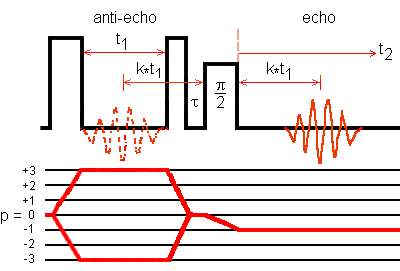
z-filter ±3QMAS pulse program for spins 3/2, 5/2, and 7/2
Contributor: Y. Millot
Below NMR pulse program describes the z-filter ±3QMAS (1D and 2D) experiment with cogwheel phase cycling or nested phase cycling applied to nuclei with 3/2, 5/2, or 7/2 spins.

Fig. 1: Z-filter ±3QMAS NMR pulse sequence and coherence transfer pathway.
The echo amplitude and the antiecho amplitude have the
same sign.
This NMR pulse program is for Bruker Avance spectrometers.
A pure absorption 2D spectrum is obtained with the shearing transformation.
; 3qzfilter.ym (XWIN-NMR 3.0) ; 01072009 ;±3Q MAS pulse program for half integer spin nuclei ;ZGOPTNS (zg-options) are: ; -DTQS3Cog ... for I=3/2 (ns=24) Cog24(0,4,19,7) = Cog24(23,3,18,6) ; -DTQS3Nes ... for I=3/2 (ns=24) nested phase cycling with standard receiver ; -DTQS5Cog ... for I=5/2 (ns=36) Cog36(0,6,29,11) = Cog36(34,4,27,9) ; -DTQS5Nes ... for I=5/2 (ns=36) nested phase cycling with standard receiver ; -DTQS7Cog ... for I=7/2 (ns=48) Cog48(0,8,25,1) = Cog48(11,19,36,12) ; -DTQS7Nesdig .for I=7/2 (ns=48) nested phase cycling with digital receiver ;d1 : recycle delay ;p1 : excitation pulse at pl11 ;p2 : conversion pulse at pl11 ;p3 : 90 degree selective pulse at pl13 ;pl1 : =120 dB ;pl11 : power level for excitation and conversion pulses ;pl13 : power level for selective pulse ;d4 : =20u, delay for z-filter ;d0 : =3u ;in0 : 1 rotation period for synchronised experiment ;td1 : number of t1-experiments ;FnMODE : States or TPPI ;Shearing use AU program xfshear (FnMode = States) ;ph31 ph30:r for receiver phase <> kpi/2 ze ; clear memory, new data replace old data, ; switch AD converter to replace mode, ; perform DS before next acquisition, 1 d1 ; recycle delay, 10u pl11:f1 ; 10 microsecond delay, ; set high power in f1 channel, (p1 ph1):f1 ; high-power excitation pulse, d0 ; delay between pulses, t1 increment, (p2 ph2):f1 ; high-power conversion pulse, d4 pl13:f1 ; set low power in f1 channel, (p3 ph3):f1 ; low-power 90° pulse, #ifdef TQS7Nesdig go=1 ph31 ph30:r ; instruction must be in that order ; signal acquisition, ; loop to 1, ns times for averaging, #else go=1 ph31 ; signal acquisition, ; loop to 1, ns times for averaging, #endif d1 mc #0 to 1 F1PH(ip1, id0) ; delay for disk I/O, store signal, ; increase FID number, ; delete memory data, ; increment p1 pulse phase by 360°/12 ; for States procedure, ; increment time d0 by in0, exit ; end of the pulse program #ifdef TQS3Cog ph10= (24) 0 1 2 3 4 5 6 7 8 9 10 11 12 13 14 15 16 17 18 19 20 21 22 23 ph1 = (12) ph10*23 ; excitation pulse phase ph2 = ph10*3 ; conversion pulse phase ph3 = ph10*18 ; 90° selective pulse phase ph31= ph10*6 ; receiver phase :(360/24)*6*m=90*m #else #ifdef TQS3Nes ph1 = (12) 0 2 4 6 8 10 ph2 = 0 ph3 = {0}*6 {1}*6 {2}*6 {3}*6 ph31= ph1*3 + ph3 #else #ifdef TQS5Cog ph10= (36) 0 1 2 3 4 5 6 7 8 9 10 11 12 13 14 15 16 17 18 19 20 21 22 23 24 25 26 27 28 29 30 31 32 33 34 35 ph1 = (12) ph10*34 ; excitation pulse phase ph2 = ph10*4 ; conversion pulse phase ph3 = ph10*27 ; 90° selective pulse phase ph31= ph10*9 ; receiver phase :(360/36)*9*m=90*m #else #ifdef TQS5Nes ph1 = (12) 0 2 4 6 8 10 ph2 = (6) {0}*6 {1}*6 {2}*6 {3}*6 {4}*6 {5}*6 ph3 = 0 ph31= ph1*3 - ph2*3 #else #ifdef TQS7Cog ph10= (48) 0 1 2 3 4 5 6 7 8 9 10 11 12 13 14 15 16 17 18 19 20 21 22 23 24 25 26 27 28 29 30 31 32 33 34 35 36 37 38 39 40 41 42 43 44 45 46 47 ph1 = (12) ph10*11 ; excitation pulse phase ph2 = ph10*19 ; conversion pulse phase ph3 = ph10*36 ; 90° selective pulse phase ph31= ph10*12 ; receiver phase :(360/48)*12*m=90*m #else #ifdef TQS7Nesdig ph1 = (12) 0 2 4 6 8 10 ph2 = 0 ph3 = (8) {0}*6 {1}*6 {2}*6 {3}*6 {4}*6 {5}*6 {6}*6 {7}*6 ph30= ph1*3 + ph3 ph31= 0 #endif #endif #endif #endif #endif #endif
This pulse program remains valid for the third pulse with strong amplitude for better excitation of off-resonance nuclei.